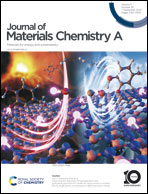Pt single atoms dispersed in a hybrid MOFox-in-nanotube structure for efficient and long-term stable photocatalytic H2 generation†
Abstract
Atomically dispersed Pt single atoms (SAs) have been reported to be a highly effective co-catalyst on TiO2 for photocatalytic H2 generation. Many TiO2 supports have been explored for hosting Pt SAs. Particularly 1D titania hosts allow for an optimized light and charge carrier management. But, attached Pt SAs often suffer from agglomeration during the photocatalytic process. In this context, titania-based metal–organic frameworks (MOFs), such as MIL-125, have attracted wide attention, as they provide stable anchoring sites for Pt SAs. To combine the beneficial features of the 1D TiO2 morphology with the SA stability, we introduce here a hierarchical structure, where the Pt SAs are dispersed in MOF-derived porous oxide features that are embedded in aligned anodic TiO2 nanotubes. This hybrid structure is intrinsically (within the nanotubes) synthesized and combines the excellent light harvesting and carrier transport properties of titania nanotubes with the beneficial features of MOF. As a result of this synergy, we obtain not only a high photocatalytic H2 evolution efficiency but most importantly a remarkably long-term stability of H2 evolution under UV light (365 nm) or simulated solar light (AM 1.5).

- This article is part of the themed collection: 1D/2D materials for energy, medicine, and devices


 Please wait while we load your content...
Please wait while we load your content...